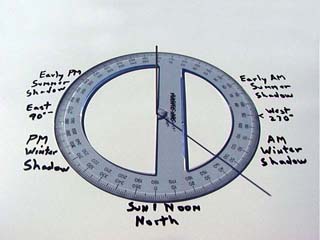Simple Sun Dial (You need a 360 protractor,
a base and computer sun position program for this.)
Most sundials are designed to read sun time which depends on the position of
the sun in the sky and don't take into account your position in the time zone
and other differences between clock time and sun time. Sun time and clock time
rarely agree. Fortunately the computer sun position programs make all the calculations
for you when you enter your position and the date. A simple flat sun dial will
demonstrate the sun's path at different times of the day and year. Learning
time in terms of azimuth is useful.
This sun dial reads time in azimuths and has a vertical rod that casts a shadow
on a protractor who's center is at the vertical rod.. If you have access to
a drill press and drills you can drill a hole in the center of a piece of plywood
or thick plastic which will hold up better in the weather. If you drill by hand
it is hard to get a perfectly vertical hole. Any thin straight rod will do.
Drill the hole so the rods fit snugly. Hobby and craft shops have small brass
rod, drills and maybe a weather proof flat base. The best protractor has 360
degree dials reading in both directions. Some have 4, 90 degree quadrant scales
that can be marked out with a felt pen. If the dial only has 360 degrees ascending
clockwise, turn it over so the degrees ascend counter clockwise. Drill or file
a notch in the middle so the rod is exactly in the center of the protractor.

Simple Sun Dial on Level Surface, Mid Morning
Place your sun dial on a level surface with 360 degrees on the protractor pointing
north. To find north check the azimuth of the sun with your sun position program
and orient the dial so the shadow agrees with the sun position program. .
At different times of the year you will want different lengths of rods. Short
in the winter and longer in the summer when the sun is higher. Of course the
shadow will fall off the dial near sunrise and sunset.
Extra Stuff
To calculate sun time from clock time, draw a clock face with a circular protractor.
(15 degrees per hour.) Mark sunrise and sunset clock time from the newspaper
or sun position program on the clock face. Divide the times and draw a line
through the middle of the clock face to the clock time of sun noon. Set an old
watch to sun time.
Picture to Come: Sun / clock time calculator.
If you don't know where north is put a shorter rod through a piece of paper
in the sun dial. An hour or more before sun noon measure and mark the distance
of the sun's shadow from the center of the dial. When the sun reaches the same
distance from the center rod after sun noon mark it. A line between these two
positions will point north. (You can draw a arc clock wise with a drafting compass
from the morning shadow toward the after noon position.)
Picture to Come: Dividing Sun's Shadow to Find North With Protractor
Place 360/0 degrees on the protractor upside down on this north line. At sun
noon the sun will be the highest it gets during the day, its shadow closest
to the rod in the center and the shadow points due north. This is not easy to
measure, You might modify a plastic ruler to help measure the sun's shadow distance
with a notch in one end.
Please send me ideas of readily available methods to make the rod vertical for
people without tools. We can share them. See Sun Position/"Monograph", "General
Sun Information", "Measuring Height of Sun", "Measuring Direction of the Sun"
© Copyright 1999-2004 Ron Dexter. All Rights Reserved.

